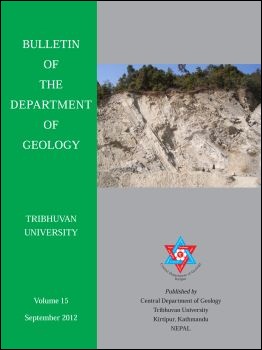Morphology and classification of the main stem Bagmati River, Central Nepal
DOI:
https://doi.org/10.3126/bdg.v15i0.7415Keywords:
Stream order, Sinuosity, Meandering River, Bagmati River, Kathmandu Basin, Sub-HimalayaAbstract
Rivers are significant geomorphic agents which can carry huge amounts of sediments and water from their catchments to depositional basins. Due course of flow they can bring various hazards such as flooding, inundation of flood plains, erosion of banks and trigger various slope movements. To understand nature and behavior of the Bagmati River, which is a perennial, storm and spring-fed, eight order river of central Nepal, the planiform morphological parameters of this river were analysed and river segments along the main stem stretches were classified into various stream-types, using topographic maps, aerial photographs, and satellite imageries. The Bagmati River is an 8th order perennial river.
The Bagmati River basin comprises 39 sub-basins of 4th order and higher. The averages of meander wavelengths (Lm), meander belt width (Wblt), radius of curvature (Rc) and sinuosity (K) of the 7th order main stem Bagmati River are 598.27 m, 164.07 m, 252.35 m and 1.38, respectively. Similarly, the averages of Lm, Wblt, Rc, and K of the 8th order main stem rivers are respectively, 496.77, 126.58 m, 286.13 m, and 1.55. All these parameters reflect fluctuating trends of variation along the downstream stretch. However, the portion of the 7th order river shows abrupt increase of Lm after the Bagmati River crosses the Main Boundary Thrust. The Rc also indicates slight increase in this region. The sinuosity reflects overall increase from the 7th to the 8th order rivers. This increase in sinuosity is attributed to the decrease in slope and competency of the river. There exists a moderate degree of correlation between K and Wblt showing that the Wblt of the Bagmati River tends to increase as the sinuosity increases.
The stream segments of the Bagmati River fall on A-, B-, C-, G- and D-type rivers. All the segments of the Bagmati River, lying within the Kathmandu Valley and having substrate of the fluvio-lacustrine valley-fill sediments, fall on C-type stream because of low entrenchment and high width/depth ratio. Similarly, A-type streams are developed at segments which flow through the Tistung Formation of the granite terrain of the Lesser Himalaya most probably due to entrenched and gorged valley and high slope. Likewise, B- and G-type streams are developed in terrains of the Lesser Himalaya and the Sub-Himalaya. The B-type streams are moderately entrenched with sinuous to meandering and wide channels. The D-type stream segment which is a multi-thread channel is characteristically developed within the terrain of the Sub-Himalaya presumably due to the change in slope caused by thrusting, and greater input of sediments from the Siwaliks in relation to weak and loosely consolidated lithology.
DOI: http://dx.doi.org/10.3126/bdg.v15i0.7415
Bulletin of the Department of Geology, Vol. 15, 2012, pp. 23-34
Downloads
Downloads
Published
How to Cite
Issue
Section
License
© Central Department of Geology, Tribhuvan University, Nepal

